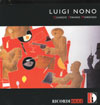Nono Choral Chamber Works
No limits to Nono’s intense, enigmatic and challenging music
View record and artist detailsRecord and Artist Details
Composer or Director: Luigi Nono
Genre:
Vocal
Label: Neos
Magazine Review Date: 4/2009
Media Format: Super Audio CD
Media Runtime: 123
Mastering:
Stereo
DDD
Catalogue Number: NEOS10801/2

Tracks:
| Composition | Artist Credit |
|---|---|
| Guai ai gelidi mostri |
Luigi Nono, Composer
André Richard, Conductor Christine Theus, Cello Ernesto Molinari, Clarinet Klaus Burger, Tuba Luigi Nono, Composer Noa Frenkel, Alto Roberto Fabbriciani, Flute South West German Radio ExperimentalStudio Susan Knight, Viola Susanne Otto, Contralto (Female alto) Ulrich Schneider, Double bass |
| Quando stanno morendo (Diario polacco No. 2) |
Luigi Nono, Composer
Alexandra Lubchansky, Soprano André Richard, Conductor Christine Theus, Cello Heike Heilmann, Soprano Luigi Nono, Composer Petra Hoffmann, Soprano Roberto Fabbriciani, Flute South West German Radio ExperimentalStudio Susanne Otto, Contralto (Female alto) |
Composer or Director: Luigi Nono
Genre:
Chamber
Label: Stradivarius
Magazine Review Date: 4/2009
Media Format: CD or Download
Media Runtime: 0
Mastering:
Stereo
Catalogue Number: STR57007

Tracks:
| Composition | Artist Credit |
|---|---|
| A Pierre. Dell'azzurro silenzio, inquietum |
Luigi Nono, Composer
Ciro Scarponi, Clarinet Luigi Nono, Composer Luigi Nono, Electronics Roberto Cecconi, Conductor Roberto Fabbriciani, Flute |
| Quando stanno morendo (Diario polacco No. 2) |
Luigi Nono, Composer
Christine Theus, Cello Ingrid Ade, Soprano Luigi Nono, Electronics Luigi Nono, Composer Monika Bayr-Ivenz, Soprano Monika Brustmann, Soprano Roberto Cecconi, Conductor Roberto Fabbriciani, Flute Susanne Otto, Contralto (Female alto) |
| Post-Prae-Ludium |
Luigi Nono, Composer
Giancarlo Schiaffini, Tuba Luigi Nono, Composer Luigi Nono, Electronics Roberto Cecconi, Conductor |
Author: Philip_Clark
Written for four female voices, electronics evolving in real time with clandestine shadowing from bass flute and cello, Nono’s setting of texts by East European poets, including Boris Pasternak, has a vulnerable, fragmented and ambiguous beauty – affirmative and unquestioning beauty would hardly be appropriate. His vocal-writing is firmly rooted in the contours of the Renaissance choral music he so loved, but is deliberately alienated. Chords hover around tritoneinterrupted progressions that deny resolution, and the four voices spend much of their time clinging obsessively to each other as though on the brink of asphyxiation.
Nono constantly pushes for further extremes – his lyrical gestures become increasingly frail and halting, as electronics add layers of disembodied humming. Later in the piece electronics are also deployed to place earsplitting walls of hectoring white noise into opposition against the voices: the instruments have a mediating role, worrying the progress of the singers, or encasing them with electronically manipulated mantras.
Stradivarius’s Quando stanno morendo was for many years the only available version and, now reissued, remains a clear and sonically faithful realisation of Nono’s intentions. But Neos’s new recording, made in June 2007, is noticeably more matured and inside the music. The pace is slowed (38' verses 33') and the vocalists enunciate with great purpose and character. Another advance is the extraordinary range of the recording: each subtone vocal whisper is made to count, and those blasts of electronica hit like terrifying body blows.
However, the Stradivarius disc is worth considering for A Pierre (for a similar chorusinstrumental- electronic ensemble) and Post- Prae-Ludium for tuba and live electronics: both are sonically rich and exacting examples of Nono’s late music. Neos add the rarely heard Guai ai gelidi mostri from 1983, which dives ever deeper into the fleeting non-gestures and structural enigmas that make Nono challenging but obligatory.
Explore the world’s largest classical music catalogue on Apple Music Classical.
Included with an Apple Music subscription. Download now.

Gramophone Digital Club
- Digital Edition
- Digital Archive
- Reviews Database
- Events & Offers
From £9.20 / month
Subscribe
Gramophone Club
- Print Edition
- Digital Edition
- Digital Archive
- Reviews Database
- Events & Offers
From £11.45 / month
Subscribe
If you are a library, university or other organisation that would be interested in an institutional subscription to Gramophone please click here for further information.






